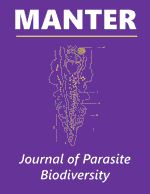Parasitology, Harold W. Manter Laboratory of
Date of this Version
4-21-2021
Document Type
Article
Citation
MANTER: Journal of Parasite Biodiversity (ISSN 2470-8224) Occasional Papers, Number 15, April 21, 2021.
doi: 10.32873/unl.dc.manter15
Abstract
The shorebird family Charadriidae in the Americas consists of 21 native and 7 vagrant species. Members of the family occupy a diversity of open habitats, ranging from Arctic tundra during nesting, coastal sands, and mudflats to inland prairies, savannas, and wetlands. Some native plovers migrate from nesting grounds in North America to wintering grounds in South America (Hayman et al., 1986; Paulson, 2005; Winkler et al., 2020). Our search of the literature revealed the following: 17 of 28 host species infected with helminth parasites, 153 helminth species, and 199 infections involving 13 geographic areas. The purpose of this guide is to provide easy access to this data and information relevant to helminth infections in charadriids from the Americas. Information is summarized in Tables I–VI. Table I lists in sequence host, parasite, geographic location, and attenuated citation. Common names are given for each host. Host names are listed alphabetically, and older scientific names used in the literature search are in parentheses. Host geographic distribution is abbreviated as follows: NA = North America, M = Mexico, CA = Central America, SA = South America, A = Americas (NA + M + CA + SA). If present, parasite species are listed in the following order: trematode, cestode, nematode, and acanthocephala. The helminth species names are listed as they were given in the cited literature. Tables II–V are parasite-host lists for trematode, cestode, nematode, and acanthocephalan species and host of the species associated with the parasite. Table VI is a summary of information extracted from the tables and literature cited section.


Comments
Copyright © 2021, A. G. Canaris, S. Capasso, and G. J. Canaris
Open access material. CC-BY-NC-SA 4.0
License: Creative Commons Attribution-NonCommercial-ShareAlike 4.0 International license